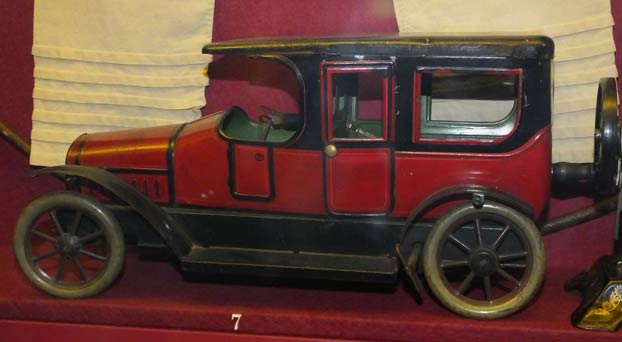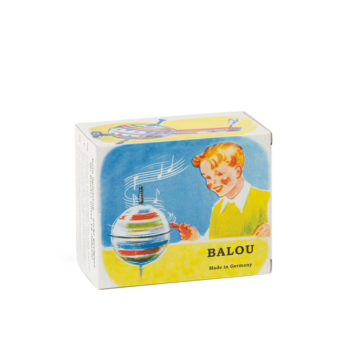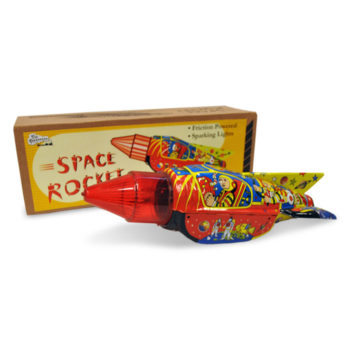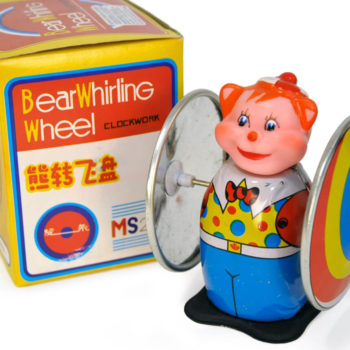Tin toys emerged in the wake of the industrial revolution, starting in the mid-19th century. Until then, toy manufacturers used wood, clay or cloth to create their pieces, with relatively small-scale production. The invention of machines for manipulating and stamping steel sheets, around 1815, enabled the mass production of toys made of tinplate.
But what is tinplate exactly?
Tinplate is simply a thin sheet of steel coated with tin. It is a light, fairly malleable and cheap material. It is also sturdy enough to resist the stress of children playing with wind-up toys, friction cars, etc.

Vintage tin toys
In the beginning, antique tinplate toys were handmade, assembled and painted by hand. In the late 1880s offset lithography was used to print on the sheet metal. Once the colourful designs were printed, the sheet metal was cut with dies and then assembled with small tabs.
At the start of the 20th century, Germany led the way in the production of mechanical tin toys. France and England also had major factories, but they were not able to match the standards of excellence of the Germans. In the United States, manufacturing companies got off to a slow start, and it was not until after World War I, with anti-German sentiment running high, that they began to take off. In the 1920s, the Americans eventually became the world’s leading market players.
The rise of Japanese tin toys
Worldwide production was interrupted during the Second World War due to the need for raw materials for battle. After the war period and the subsequent European recession, interest in tinplate toys continued to grow and new large-scale production sites sprang up.
Under American tutelage, Japanese manufacturers were allowed to resume business, including the right to export the toys. The idea was to produce a tinplate toy at low cost and then sell it on the US market as an imported product. Over the years, the Oriental industry was able to draw on its rich artistic tradition in enamelling and metalworking. In addition to the traditional wind-up mechanism, new movement systems were incorporated and sounds and brightly coloured lights were added to the toys.

Another strength of Japanese industry was to create pieces that connected more directly with the imaginative world of children. Depictions of cute little animals, curious insects, the cheerful and colourful theme of the circus, rockets for star travel, and so on. Not forgetting, of course, the Japanese fascination with robotics, creating a great variety of tin robot models, which over time have become a symbol of the toy industry in the Asian country.
As a result, Japan became a powerful tinplate toy factory, enjoying a very good reputation in international markets. However, from the 1960s onwards, there began a gradual decline not only of Japan as a manufacturing force, but of the tinplate industry as a whole.
The tin toy for collectors
The progressive decline of tinplate began with the increasing use of plastic as a raw material. In addition, new child safety standards set by governments made metal obsolete, expensive and unsuitable for toy manufacture. And the coup de grâce came with changes in consumer habits, which gradually shifted towards more technological toys such as video game consoles.

Today, China has assumed the role of the leading manufacturer of tin toys, but from a completely nostalgic point of view. Instead of creating new pieces, the general trend is to evoke memories of times gone by, reviving classic toys from the 40s, 50s and 60s. It is not surprising then that most of these “new” toys are aimed at collectors.
Some of the original antique toys can be found in the Toy Museum in Nuremberg, Germany, with more than 80,000 objects. You can also visit the Kyoto Toy and Tin Doll Museum, with 10,000 toys on display. Here, unlike in other museums, many of the items are for sale, but in order to take them home, you have to pay a good deal of money. Because a piece from the period, mainly the original tin robots, can sell for several thousand euros. Ouch!













